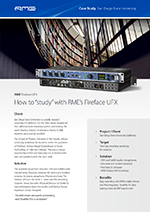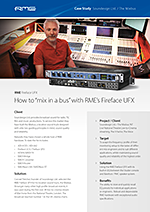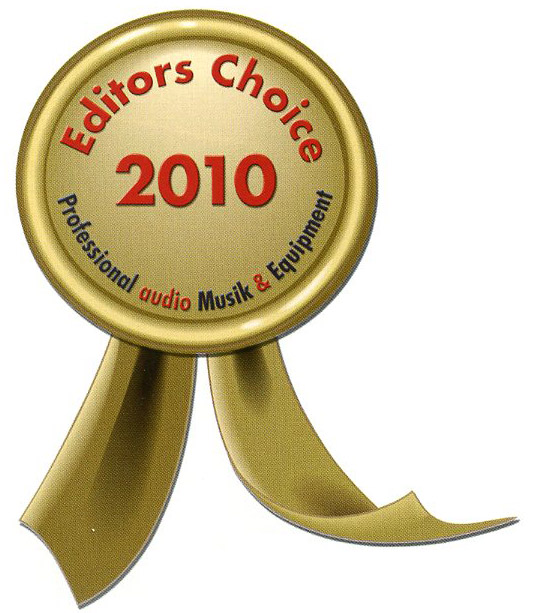FireWire & USB
- Overview
- MADIface XT
- MADIface USB
- MADIface Pro
- Babyface Pro
- Fireface UCX
- Fireface UC
- Fireface 802
- Fireface UFX II
- Fireface UFX+
- Digiface USB
- Digiface AVB
- Digiface Dante
more information
- Tested Systems
- Frequently asked questions
- Manual
- Mode d'emploi (french manual)
- Guía del usuario (Esp)
- Manual (RUS)
Case study
Awards
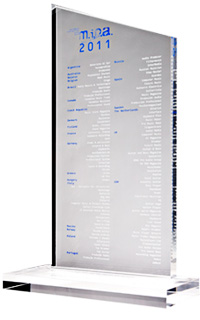
International press award: mipa 2011

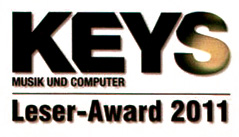
Keys Readers Choice
Award 2011
Reviews
- AudioFanzine
- Audio Media 11/2010
- Audio Technology 80
- by Audio Technology Magazin
- Studio Magazin 10/2010
Videos
(MusoTalk TV)
(DelamarTV)
(SAE alumniTV)
RME Fireface UFX: Frequently asked questions.
Is the Fireface UFX the successor of the Fireface 800?
Can I use the Fireface UFX stand-alone?
Can I use the UFX on a USB and FireWire port at the same time?
What is better: USB or FireWire?
Can I use the UFX on a FireWire 800 port?
Can I use the UFX on an USB 3.0 port?
What performance can I expect from the USB bus?
Can I use the Fireface UFX with bus-power?
Can I connect more devices to the same USB bus
What can I do with the USB port in the front?
How many effects can I use with TotalMix?
Can I use the Fireface UFX together with other RME FireWire or USB hardware?
How do you calculate all the effects? Inside the famous RME FPGA?
Will you open the DSP to 3rd party developers?
Is the volume knob an analog attenuator positioned after the DAC, or is it a digital level change?
Why does the Fireface UFX support +24 dBu only on the main out?
Can I plug in balanced line level plugs into front panel unbalanced TRS inputs?
Is it possible to use two or three UFX & Fireface to get more channels?
I couldn't find any information about latencies introduced by the FX-section.
Is the Fireface (UFX) compatible with Pro Tools 9?
Is the Fireface UFX the successor of the Fireface 800?
No. The UFX extends the RME line of interfaces to the highest end. The Fireface 800 still remains the state-of-the-art FireWire 800 audio interface and one of today's best selling RME interfaces. It continues to be "one of the (if not the) most reliable and well featured external audio interface ever" (quoting a user post). It will have full support with further driver updates.
Can I use the Fireface UFX stand-alone?
Yes. The Fireface UFX is completely usable without any connection to a PC or Mac. All important features are usable and adjustable with the help of the display and the encoder buttons. The Fireface UFX can store and load its current state in 6 different memory slots, called Setups. With this, the Fireface UFX can be used stand-alone after setting it up accordingly, and can transform into totally different devices by the simple click of a button.
Examples:
- 12-channel AD/DA-Converter
- 4-channel Mic Preamp
- Monitor Mixer
- Digital Format Converter
- Analog / Digital Routing Matrix
Can I use the UFX on a USB and FireWire port at the same time?
No. With simultanious connection the port is used which is initialized from the operating system first. For example for the installation of the FireWire driver it's necessary to disconnect the USB cable.
What is better: USB or FireWire?
Only a test on your individual system can show. Theoretically the UFX will perform equally well on both connection protocols. Note that USB works best on up-to-date computers, while FireWire might have an advantage on older computers.
Can I use the UFX on a FireWire 800 port?
Yes. You just need a plain FireWire 800 <> 400 cable or adapter. The FW 800 port is fully downward compatible to FW 400.
Can I use the UFX on an USB 3.0 port?
Yes. The Fireface UFX is compatible to USB 3.
What performance can I expect from the USB bus?
A Fireface UFX can achieve a performance similar to a PCI or PCI Express card when used with an optimal PC. Low CPU load and click-free operation even at 48 samples buffer size are indeed possible on current computers.
Like any audio interface the Fireface should have a data transmission to the computer as undisturbed as possible. The easiest way to guarantee this is to connect it to its own USB bus, which should be no big problem as most USB 2.0 interfaces are a double bus design. See the manual for details.
Can I use the Fireface UFX with bus-power?
No. Neither a FireWire nor USB port can deliver the necessary amount of power.Can I connect more devices to the same USB bus?
Most devices do not pose a problem. Even devices with higher bandwidth requirements like hard drives will usually work as the audio interface has priority. Simply check it out.
What can I do with the USB port in the front?
The USB socket in the front is intended for the multi-track recording/playback directly to USB memory stick or USB hard drive (DURec = Direct USB Recording).
How many effects can I use with TotalMix?
That depends on the specific configuration and combination. But even at 192 kHz there is enough DSP power for nearly any effect combination you will ever need.
Can I use the Fireface UFX together with other RME FireWire or USB hardware?
This feature is included but not officially supported. Use at your own risk. All RME FireWire and USB interfaces use the same drivers respectively, so can be used together in an ASIO application. It only needs a hardware clock sync via a digital I/O (ADAT/SPDIF) or Word Clock I/O.
So while it should be possible to use e.g. a UFX with a Fireface 800 or 400 (FireWire driver) or a Fireface UC (USB driver), bandwidth limitations and other real-world problems might bring up various problems. In that case RME will not be available for help and support.
How do you calculate all the effects? Inside the famous RME FPGA?
No. The Fireface UFX has a dedicated and very powerful Texas Instrument Floating Point DSP which is used for everything except routing/mixing, which still happens within the FPGA.
Will you open the DSP to 3rd party developers?
Definitely not.
Is the volume knob an analog attenuator positioned after the DAC, or is it a digital level change?
The level is changed in the digital domain for various reasons. An analog attenuator suffers from many issues:
- No reproducible gain setting. The RME design provides a digital control and recall of all settings. This has many advantages, not only for the interaction with TotalMix on the host computer.
- No error-free gain operation and linearity problems: analog attenuators (potentiometers) never match 100% between both stereo channels. But even within the range of one channel the pot never operates perfectly, especially at the end (highest/lowest) position.
- Scratch and dropout noises: Typical mechanical problems of potentiometers and/or switches within the audio path.
- Limited to stereo control. Pots are usually limited to stereo. The digital control makes it easy to perfectly control a 5.1 setup from one knob, like the UFX volume knob.
- Change of frequency response in the extreme settings. High resistance at the lower and/or higher positions generate high or lowpass filter functions that will change the sound.
These disadvantages compensate any theoretical loss by the bit resolution. Which is by the way just digital theory, having no proof in the real world. Lower volume signals will just vanish within the DAC noise floor, but not cause distortion or other artifacts. With a SNR of 118 dBA at its outputs the UFX has a lot of dynamic range for matching monitors over a wide level range without its noise being hearable. Simply said: if you cannot hear its noise, then you cannot hear any digital level control artifacts. And if you could, you would just hear noise, nothing else.
If the host computer crashes and goes into a mega decibel noise burst loop can I still control the volume at the unit?
Yes. The UFX cannot 'crash' internally, the big volume knob will work even if the PC/Mac crashes. This way no external controller is needed to prevent damage of speakers and ears.
Why does the Fireface UFX support +24 dBu only on the main out? Providing +24 dBu on all I/Os would be necessary to use the UFX in american broadcast stations.
The UFX uses 15V power inside, therefore its servo balanced design is limited to +21 dBu peak output. We think that the servo balanced design - especially with the TRS jacks - is of much more value to many customers than a UFX with standard balanced design for the small american broadcast market. And of course the units input stage would have been more complicated - means expensive - for supporting +24 dBu.
The RME ADI-8 QS - which could be used as an AD/DA converter for the UFX - therefore has double output stages, one on TRS servo-balanced, one on D-sub not servo-balanced, and the latter can then do up to +24 dBu. The Micstasy uses XLR outs only, and therefore has not been designed servo balanced, so +24 dBu are also available here.
Can I plug in balanced line level plugs into front panel unbalanced TRS inputs?
Yes. The level will be -6 dB compared to a real balanced or servo-balanced input, and naturally there is no CMRR available. Note that the front XLR inputs can also be used with balanced Line levels of up to +12 dBu, with full CMRR.
How does AutoLevel work? Does it mean that 0 dBFS peaks are 100% avoided with AutoLevel turned on regardless of source input level?
AutoLevel works completely digital and therefore can not prevent hardware overload and clipping on the analog input stage. AutoLevel is designed as slow volume tracker, but with faster settings can also have an effect similar to a Maximizer. It can also operate like a Peak Limiter if set up accordingly. Basically it works as gain raiser, while a compressor works the other way round, as gain reducer.
If used on the Hardware Outputs, AutoLevel can prevent too high output levels. The mixer's internal processing can generate levels of up to +24 dB without clipping (internal mixer headroom), so the output faders have to be pulled down to avoid hardware output clipping. See factory preset 'Output Protector' to get such output protection from overload.
Is it possible to use two or three UFX & Fireface to get more channels?
In real-world operation more than one unit can lead to problems on the USB and FireWire bus, caused by the high number of channels.
The Fireface 800 uses FireWire 800 to support multiple unit operation. But there are many reasons why it can fail or not work optimally. We have also repeatedly seen people using it the wrong way - 3 units and each unit only used with the 10 channels analog I/O, completely overloading the FireWire bus, where one should have simply used the additional units in standalone mode connected via ADAT.
For these and a few more reasons, like the comparable bandwidth on USB with multiple units, the separated TotalMix per unit and the Monitor Controller which is only needed once, we decided to use a FireWire 400 interface with the UFX and no longer support this kind of operation. The unit has enough channels for most applications. In our opinion it makes more sense to connect external AD/DA converters - a 2nd or 3rd UFX is also possible - to the ADAT I/Os of the (first and only) UFX, adding up to 16 channels of analog record and analog playback.
In short: multiple units might be possible, but are completely on user's risk. So if it doesn't work we can not help.
I couldn't find any information about latencies introduced by the FX-section. Does there exist any exact data? It would be very interesting to know how many samples of latency are introduced by each effect (EQ, Dynamics).
There is no further delay, all effects are calculated real-time.
How does the RME Advanced Parallel Conversion work? Why you use this design only for the four preamps?
The UFX uses two 8-channel super low latency AD-converters from Cirrus Logic, the same family as used in the ADI-8 QS. With a total of 12 analog inputs 4 ADCs are left and not wasted but intelligently used to improve the SNR of the four mic preamps. Parallel conversion with two ADCs produces a 6 dB higher digital output level that needs to be reduced and processed. In the end noise and all similar non-static side effects are reduced by about 3 dB compared to the audio signal.
The Advanced Parallel Conversion works tremendously well, and allows to get the full performance out of the PGA 2500 mic preamp chip used in the UFX. The other eight line inputs of the UFX would not benefit as much from such a design, as their three reference level analog input stages have a self-noise on a level comparable to the converters (around -109 dBFS unweighted).
I need a coaxial SPDIF I/O!
The AES/EBU I/O of the UFX can be switched to 'Consumer' mode, which is SPDIF. Now all it needs is a simple, passive cable adapter XLR to RCA, which is described in the manual.
Is the Fireface (UFX) compatible with Pro Tools 9?
Yes. There is no specific "compatibility" with PT 9. PT 9 works with audio cards that use standard ASIO and Core Audio drivers, which includes all RME devices.






